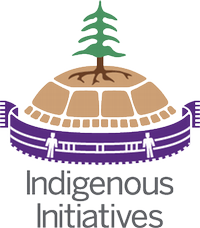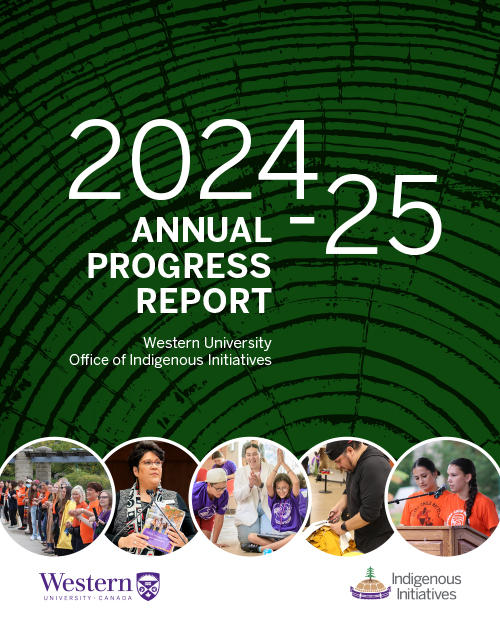Our Logo Story
Our Logo Story: A Wampum Learning Journey

Learning is a lifelong journey that takes people to many places during their lifetimes. Western University is fortunate to be a place where many Indigenous students come to learn, and to which they bring their Indigeneity and Indigenous ways of knowing. The Indigenous Initiatives logo and wampum learning journey began with Indigenous students, who continue to be our greatest teachers and leaders in the movement to decolonize and Indigenize the academy.
During their first year at Western, Mishiikenh Nini (Jason George), from Kettle and Stony Point First Nation and Katsitsyahawi (Lori George), from Oneida Nation of the Thames, were grappling with being Indigenous in the academy. “When are we going to hear our voices at the University?” they wondered. “When are we going to feel at home here?”
At this time, Western’s Indigenous Student Centre was planning to create a graphic to represent the Centre, a logo that would incorporate elements signifying Indigenous peoples and Indigenous ways of knowing. Together with Western’s Indigenous Studies program, the Centre established two work-study positions and began a search for graphic designers, eventually offering the positions to Katsityahawi and Mishiikenh Nini.
One night, Katsitsyahawi dreamt about a wampum belt. The belt was held at Indigenous Services and people were gathered around it. Katsitsyahawi felt the power of this belt in bringing everyone together and how much they all cared for one another.
Through the dream, the couple was inspired to make the wampum a reality. They developed a logo design that contains a pine tree to represent the Great Tree of Peace, a symbol of unity of the Haudenosaunee Confederacy. The pine tree grows from the top of a turtle shell. The turtle is a significant figure in many Indigenous creation stories, and Turtle Island is the common name for North America among most Indigenous peoples. From the base of the pine tree, four strong roots corresponding to the four sacred cardinal directions reach out across the shell. The needles of the pine tree grow in clusters symbolizing the unity of all Indigenous Nations and reminding humans that we are stronger together. While Indigenous students at Western hail from many different Nations across Turtle Island, the design reminds us of common teachings embodying unity and representing the generosity of the turtle.
The wampum design embodies deep meaning about relationships and responsibilities to each other, and the symbolism alludes to other wampum that came before it. In the wampum, two humans are joined by eight beads running between them. The human on the left represents the Indigenous Initiatives team (formerly the Indigenous Student Centre) and the human on the right represents Indigenous students. The humans are joined by eight beads representing the seven guiding principles of the Centre: academic excellence; collaboration; balance; diversity, equity and inclusion; interconnection; personal and cultural identity; and respect. There is purposely one bead out of place to remind us that mistakes are part of learning.
Today, the Office of Indigenous Initiatives uses Katsitsyahawi’s and Mishiikenh Nini’s graphic design as its logo. Even though Katsitsyahawi and Mishiikenh Nini have long since graduated, a tradition of weaving a replica of the wampum belt together in community lives on in practice every year. Indigenous ways of doing are reflective of what Mishiikenh Nini always maintained was the intention of creating the wampum design—that it should take on a life of its own. “If the wampum chooses to live on,” Mishiikenh Nini said, “that’s its purpose; it’s there for the people.”
What are Wampum?
Wampum belts are long-standing traditions among many Indigenous Nations across Turtle Island. They are created to codify relationships, mark treaty agreements, and honour spirits. Many agreements between early settlers and Indigenous peoples were formed with wampum first, and only documented on paper later.
As part of wampum practices, purple and white shells from the quahog, a large clam that lives along the Atlantic coast, are harvested and made into beads. These are later woven into belts with patterns and shapes that tell stories that are part of long-standing oral traditions. Within academic institutions, knowledge tends to be written down, documented in books and publications. But among the Anishinaabeg and Haudenosaunee, wampum belts carry and pass on knowledge in different ways. The belts act as mnemonic devices that help people and communities remember and retell important teachings and relationships.
Unfortunately, like many Indigenous languages and ways of knowing, wampum traditions have been misunderstood and diminished. Indigenous knowledge keepers, however, have struggled to maintain wampum traditions, and wampum knowledge and practices are being actively reclaimed by many Indigenous people today as part of a larger decolonial movement.
Respecting & Protecting Indigenous Knowledges
The wampum design forms part of the Indigenous Initiatives’ logo. Over the years, the practice of actually weaving wampum belt replicas has also grown. Having our own wampum has encouraged us to learn about wampum and oral histories, and has sparked curiosity about working with Indigenous Knowledge Holders. Every year, Indigenous Initiatives strives to incorporate wampum teachings into our learning and to create replicas of various wampum belts, including our own, with glass beads. We have learned that the relational act of gathering, weaving, and remembering wampum teachings and responsibilities reinforces our kinship with each other and the land. We are grateful for this gift.

